begin quote from:
- Irkutsk (Russian: Иркутск; IPA: ) is a city and the administrative center of Irkutsk Oblast, Russia, and one of the largest cities in Siberia.
Irkutsk
From Wikipedia, the free encyclopedia
For other uses, see Irkutsk (disambiguation).
| Irkutsk (English) Иркутск (Russian) |
|
|---|---|
| - City[1] - | |
|
Industrial panorama in Irkutsk |
|
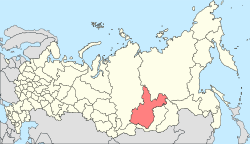 Location of Irkutsk Oblast in Russia |
|
|
|
|
|
|
|
|
|
|
| City Day | First Sunday of June[citation needed] |
| Administrative status (as of December 2011) | |
| Country | Russia |
| Federal subject | Irkutsk Oblast[1] |
| Administratively subordinated to | City of Irkutsk[2] |
| Administrative center of | Irkutsk Oblast,[2] Irkutsky District,[2] City of Irkutsk[2] |
| Municipal status (as of December 2004) | |
| Urban okrug | Irkutsk Urban Okrug[3] |
| Administrative center of | Irkutsk Urban Okrug,[3] Irkutsky Municipal District[4] |
| Mayor[5] | Dmitri Berdnikov[5] |
| Representative body | Duma[citation needed] |
| Statistics | |
| Area | 277 km2 (107 sq mi)[6] |
| Population (2010 Census) | 587,891 inhabitants[7] |
| - Rank in 2010 | 24th |
| Density | 2,122/km2 (5,500/sq mi)[8] |
| Time zone | IRKT (UTC+08:00)[9] |
| Founded | 1661[10] |
| Postal code(s)[11] | 664xxx |
| Dialing code(s) | +7 3952[12] |
|
|
|
| Irkutsk on Wikimedia Commons | |
Contents
History
| This article needs additional citations for verification. (August 2012) (Learn how and when to remove this template message) |
Irkutsk Castle in 1735
Irkutsk Assembly of the Nobility in the early 1900s
Epiphany Cathedral and central Irkutsk in 1865
In 1879, on July 4 and 6, the palace of the (then) Governor General, the principal administrative and municipal offices and many of the other public buildings were destroyed by fire, and the government archives, the library and the museum of the Siberian section of the Russian Geographical Society were completely ruined. Three-quarters of the city was destroyed, including approximately 4,000 houses. However, the city quickly rebounded, with electricity arriving in 1896, the first theater being built in 1897 and a major train station opened in 1898. The first train arrived in Irkutsk on August 16 of that year. By 1900, the city had earned the nickname of "The Paris of Siberia."
Irkutsk in 1918
Irkutsk was the administrative center of the short-lived East Siberian Oblast, which existed from 1936 to 1937. The city subsequently became the administrative center of Irkutsk Oblast after East Siberian Oblast was divided into Chita Oblast and Irkutsk Oblast.
During the Communist years, the industrialization of Irkutsk and Siberia in general was heavily encouraged. The large Irkutsk Reservoir was built on the Angara River between 1950 and 1959 in order to facilitate industrial development.
Epiphany Cathedral (built in 1718–1746)
Geography
The city proper lies on the Angara River, a tributary of the Yenisei, 72 kilometers (45 mi) below its outflow from Lake Baikal and on the bank opposite the suburb of Glaskovsk. The river, 580-meter (1,900 ft) wide, is crossed by the Irkutsk Hydroelectric Dam and three other bridges downstream.The Irkut River, from which the town takes its name, is a smaller river that joins the Angara directly opposite the city. The main portion of the city is separated from several landmarks—the monastery, the fort and the port, as well as its suburbs—by another tributary, the Ida (or Ushakovka) River. The two main parts of Irkutsk are customarily referred to as the "left bank" and the "right bank", with respect to the flow of the Angara River.
Irkutsk is situated in a landscape of rolling hills within the thick taiga that is typical in Eastern Siberia.
According to the regional plan, Irkutsk city will be combined with its neighboring industrial towns of Shelekhov and Angarsk to form a metropolitan area with a total population of over a million.
Climate
Irkutsk originally had a borderline subarctic climate (Köppen climate classification Dwc). Since 2000, the temperatures have resembled a humid continental climate (Köppen climate classification Dwb). Snow cover disappeared earlier, from late April in the 1930s to late March in the 1980s. Discontinuous permafrost depth had decreased from 200 m to 100 m during the same period.Irkutsk is characterized by an extreme variation of temperatures between seasons. It can be very warm in the summer, and very cold in the winter. However, Lake Baikal has its effect, such that temperatures in Irkutsk are not as extreme as elsewhere in Siberia. The warmest month of the year in Irkutsk is July, when the average temperature is +18 °C (64 °F), the highest temperature recorded being +37.2 °C (99.0 °F).
The coldest month of the year is January, when the average temperature is −18 °C (0 °F), and record low of −49.7 °C (−57.5 °F). Precipitation also varies widely throughout the year, with July also being the wettest month, when precipitation averages 113 millimeters (4.4 in). The driest month is February, when precipitation averages only 7.6 millimeters (0.30 in). Almost all precipitation during the Siberian winter falls as fluffy, low moisture content snow.
| [hide]Climate data for Irkutsk (normals 1981–2010) | |||||||||||||
|---|---|---|---|---|---|---|---|---|---|---|---|---|---|
| Month | Jan | Feb | Mar | Apr | May | Jun | Jul | Aug | Sep | Oct | Nov | Dec | Year |
| Record high °C (°F) | 2.3 (36.1) |
10.2 (50.4) |
20.0 (68) |
29.2 (84.6) |
34.5 (94.1) |
35.6 (96.1) |
37.2 (99) |
34.1 (93.4) |
29.0 (84.2) |
24.5 (76.1) |
14.4 (57.9) |
5.3 (41.5) |
37.2 (99) |
| Average high °C (°F) | −12.8 (9) |
−7.8 (18) |
0.3 (32.5) |
9.4 (48.9) |
18.1 (64.6) |
22.7 (72.9) |
24.8 (76.6) |
22.2 (72) |
15.7 (60.3) |
7.7 (45.9) |
−2.7 (27.1) |
−10.6 (12.9) |
7.3 (45.1) |
| Daily mean °C (°F) | −17.8 (0) |
−14.4 (6.1) |
−6.4 (20.5) |
2.5 (36.5) |
10.2 (50.4) |
15.4 (59.7) |
18.3 (64.9) |
15.9 (60.6) |
9.2 (48.6) |
1.8 (35.2) |
−7.6 (18.3) |
−15.3 (4.5) |
1.0 (33.8) |
| Average low °C (°F) | −21.8 (−7.2) |
−19.6 (−3.3) |
−12.2 (10) |
−2.8 (27) |
3.6 (38.5) |
9.3 (48.7) |
13.0 (55.4) |
10.9 (51.6) |
4.3 (39.7) |
−2.5 (27.5) |
−11.6 (11.1) |
−19.1 (−2.4) |
−4 (25) |
| Record low °C (°F) | −49.7 (−57.5) |
−44.7 (−48.5) |
−37.3 (−35.1) |
−31.8 (−25.2) |
−14.3 (6.3) |
−6 (21) |
0.4 (32.7) |
−2.7 (27.1) |
−11.9 (10.6) |
−30.5 (−22.9) |
−40.4 (−40.7) |
−46.3 (−51.3) |
−49.7 (−57.5) |
| Average precipitation mm (inches) | 13 (0.51) |
8 (0.31) |
12 (0.47) |
18 (0.71) |
37 (1.46) |
78 (3.07) |
114 (4.49) |
91 (3.58) |
52 (2.05) |
21 (0.83) |
20 (0.79) |
16 (0.63) |
480 (18.9) |
| Average rainy days | 0 | 0.04 | 1 | 9 | 15 | 18 | 18 | 17 | 16 | 9 | 2 | 0 | 105 |
| Average snowy days | 21 | 16 | 13 | 11 | 3 | 0.2 | 0 | 0 | 2 | 10 | 20 | 23 | 119 |
| Average relative humidity (%) | 82 | 76 | 65 | 56 | 55 | 67 | 74 | 78 | 76 | 73 | 79 | 85 | 72 |
| Mean monthly sunshine hours | 93 | 149 | 207 | 223 | 266 | 264 | 243 | 218 | 182 | 152 | 93 | 62 | 2,142 |
| Source #1: Pogoda.ru.net[15] | |||||||||||||
| Source #2: NOAA (sun, 1961–1990)[16] | |||||||||||||
Administrative and municipal status
Irkutsk is the administrative center of the oblast and, within the framework of administrative divisions, it also serves as the administrative center of Irkutsky District,[2] even though it is not a part of it.[citation needed] As an administrative division, it is incorporated separately as the City of Irkutsk[1]—an administrative unit with the status equal to that of the districts.[citation needed] As a municipal division, the City of Irkutsk is incorporated as Irkutsk Urban Okrug.[3]Coat of arms
The original version of the coat of arms
A fountain in Kirov Square
By the mid-19th century, the word "babr" had fallen out of common usage, but it was still recorded in the Armorial of the Russian Empire. Furthermore, the tigers became extinct in this part of Siberia. In the 1870s, a high-placed French heraldist with a limited command of Russian assumed that "babr" was a misspelling of "bobr", the Russian word for "beaver", and changed the wording accordingly. This modification engendered a long dispute between the local authorities, who were so confused by the revised description that they started to depict the "babr" as a fabulous animal, half-tiger and half-beaver.
The Soviets abolished the image altogether, but it was restored following the dissolution of the Soviet Union.
Economy
Energy
The 662.4 MW Irkutsk Hydroelectric Power Station was the first cascade hydroelectric power station in the Irkutsk region. The construction of the dam started in 1950 and finished in 1958.[17]Industry
The largest industry in Irkutsk is Irkut, the Irkutsk Aviation Industrial Association,[18] which was set up in 1932 in the Transbaykal region of the Soviet Union. It is best known as being the manufacturer of the Su-30 family of interceptor/ground-attack aircraft. The Russian government is planning to merge Irkut with Ilyushin, Mikoyan, Sukhoi, Tupolev, and Yakovlev as a new company named United Aircraft Building Corporation.[19]There is the Irkutsk Aluminium Smelter which belongs to the Rusal Company.[20]
Transportation
Passenger railway station in Irkutsk
Tram in Irkutsk
The Federal road and railway to Moscow and Vladivostok pass through the other side of the Angara River from central Irkutsk.
Trams are one major mode of public transit in Irkutsk. Other modes are trolleybus, bus, and fixed-route taxi (marshrutka).
Culture
Irkutsk Academic Drama Theater
Television and mass media
There are many state-owned and privately owned television stations in Irkutsk, including state company IGTRK[21] and private ones, such as AS Baikal TV,[22] TV company AIST,[23] TV company Gorod,[24] and also other media outlets, like the VSP Newspaper Agency.[25] There is also a live webcam broadcasting from the city center.[26]Education
Irkutsk is home to the East Siberian Education Academy (since 1909), Irkutsk State University (1918), Irkutsk State Medical University (1918), Baykalsky State University of Economics and Law (since 1932), Irkutsk State Technical University (since 1939), Irkutsk State Academy of Agriculture, Irkutsk State Linguistic University (1948), Irkutsk State Railway Transport University (since 1975), and a number of private colleges: Siberian Institute of Law, Economics and Management (since 1993), Institute of Economics of ISTU (since 1996), and others.Science
As Irkutsk is within the influence of the Siberian Division of the Russian Academy of Sciences, there are nine research institutes located in the Irkutsk Academgorodok suburb: the Institute of Geography, the Energy System Institute, the Institute of Geochemistry, the Institute of System Dynamics and Control Theory, the Earth's Crust Institute, the Solar-Terrestrial Physics Institute, the Institute of Chemistry, the Limnological Institute (formerly located on Lake Baikal's shore), the Institute of Plant Physics, Laser Physics Institute (a Branch of the Institute of Laser Physics in Novosobirsk). A number of institutes conduct research within Irkutsk State University: the Institute of Biology, the Institute of Oil and Coal Chemistry and Synthesis, the Laboratory of Quantum Chemistry, the Institute of Applied Physics, the Interregional Institute of Social Studies, the Astronomical Observatory, and the Botanical Gardens. The East-Siberian Scientific Center of the Russian Academy of Medical Sciences is also located in Irkutsk and is represented by the following research organizations: the Scientific Center for Medical Ecology, the Institute for Paediatrics and Human Reproduction, the Institute for Microbiology and Epidemiology, the Institute for Medicine of the Workplace and Human Ecology, the Institute of Reconstructive and Restorative Surgery, the Institute of Surgery, and the Institute of Traumatology and Orthopaedics. Also, the Fyodorov Eye Microsurgery Scientific and Technical Center has a branch in Irkutsk. Additionally, there are R&D institutes including GAZPROM R&D Institute (a Branch of a Moscow-based institute), the Irkutsk Institute of Rare and Precious Metals and Diamonds (Irgiredmet), part of the Petropavlovsk Group of Companies.,[27] and the Vostoksibacademcenter of the Russian Academy of Architecture and Construction Sciences that publishes the Project Baikal journal.Literature
Irkutsk has long been home to the well-known Russian writer Valentin Rasputin; many of his novels and stories take place in the Angara Valley. An essay on the cultural history of Irkutsk (and another one about the nearby Lake Baikal) is included in Rasputin's non-fiction collection Siberia, Siberia, which is also available in an English translation.Museums
The Church of the Cross (1747–60) is a pinnacle of the Siberian Baroque architecture
The Botanic Garden of the Irkutsk State University known as the "Irkutsk Botanic Garden" is the only botanic garden as a living museum in Irkutsk Oblast and Baikalian Siberia. Its mission is "to protect and enrich the flora of the Lake Baikal area and the world for people through public education, collection, propagation, research, and conservation of plants". The garden is mainly an educational and scientific tool for the Irkutsk State University and maintains the largest plant collection of living plants in Eastern Siberia (more than 5000 plant taxa), a herbarium, and a seed bank. It occupies 27 hectares within Irkutsk city, 70 km (43 mi) West of Lake Baikal. It has a federal status of especially protected land and a nature memorial of Irkutsk.
Theaters
Irkutsk is also home to several theaters, including the Okhlopkov Drama Theater, one of Russia's oldest.[30]Sports
Bandy is a very big sport in the city. There are several clubs, most notably Baykal-Energiya[31] of the Russian Bandy Super League, which can draw spectator crowds of 30,000.[32] It is also the centre of women's bandy in Russia with the club Rekord,[33] which provides most players to the national team.[34] 2012 Women's Bandy World Championship[35] was hosted in Irkutsk and received praise from Federation of International Bandy.[36] 2014 Bandy World Championship was played in the city.[37][38] The final of Russian Bandy Super League 2016 will be played at Rekord Stadium.[1]International relations
Twin towns – sister cities
Irkutsk is twinned with:[39][40]References
Notes
Sources
- Законодательное Собрание Иркутской области. Постановление №9/5-ЗС от 15 апреля 2009 г. «Устав Иркутской области», в ред. Закона №2-У от 7 июля 2015 г. «О поправках к Уставу Иркутской области». Вступил в силу по истечении десяти дней после дня официального опубликования. Опубликован: "Областная", №45, 24 апреля 2009 г. (Legislative Assembly of Irkutsk Oblast. Resolution #9/5-ZS of April 15, 2009 Charter of Irkutsk Oblast, as amended by the Law #2-U of July 7, 2015 On Amending the Charter of Irkutsk Oblast. Effective as of the day following a ten-day period after the day of the official publication.).
- Законодательное Собрание Иркутской области. Закон №49-ОЗ от 21 июня 2010 г. «Об административно-территориальном устройстве Иркутской области», в ред. Закона №183-ОЗ от 31 декабря 2014 г. «Об отдельных вопросах административно-территориального устройства Иркутской области и о внесении изменений в Закон Иркутской области "Об административно-территориальном устройстве Иркутской области"». Вступил в силу после дня официального опубликования. Опубликован: "Областная", №71, 25 июня 2010 г. (Legislative Assembly of Irkutsk Oblast. Law #49-OZ of June 21, 2010 On the Administrative-Territorial Structure of Irkutsk Oblast, as amended by the Law #183-OZ of December 31, 2014 On Various Issues Regarding the Administrative-Territorial Structure of Irkutsk Oblast and on Amending the Law of Irkutsk Oblast "On the Administrative-Territorial Structure of Irkutsk Oblast". Effective as of after the day of the official publication.).
- Законодательное Собрание Иркутской области. Закон №88-оз от 16 декабря 2004 г. «О статусе и границах муниципального образования "город Иркутск" Иркутской области». Вступил в силу с 31 декабря 2004 г., но не ранее чем через 10 дней со дня официального опубликования. Опубликован: "Восточно-Сибирская правда", №254–255, 20 декабря 2004 г. (Legislative Assembly of Irkutsk Oblast. Law #88-oz of December 16, 2004 On the Status and Borders of the Municipal Formation of the "City of Irkutsk" of Irkutsk Oblast. Effective as of December 31, 2004, but not earlier than 10 days after the official publication date.).
- Законодательное Собрание Иркутской области. Закон №94-оз от 16 декабря 2004 г. «О статусе и границах муниципальных образований Иркутского района Иркутской области», в ред. Закона №106-ОЗ от 6 ноября 2012 г. «О внесении изменений в Закон Иркутской области "О статусе и границах муниципальных образований Иркутского района Иркутской области"». Вступил в силу с 31 декабря 2004 г., но не ранее чем через 10 дней со дня официального опубликования. Опубликован: "Восточно-Сибирская правда", №254–255, 20 декабря 2004 г. (Legislative Assembly of Irkutsk Oblast. Law #94-oz of December 16, 2004 On the Status and Borders of the Municipal Formations of Irkutsky District of Irkutsk Oblast, as amended by the Law #106-OZ of November 6, 2012 On Amending the Law of Irkutsk Oblast "On the Status and Borders of the Municipal Formations of Irkutsky District of Irkutsk Oblast". Effective as of December 31, 2004, but not earlier than 10 days after the official publication date.).
 This article incorporates text from a publication now in the public domain: Chisholm, Hugh, ed. (1911). "article name needed". Encyclopædia Britannica (11th ed.). Cambridge University Press.
This article incorporates text from a publication now in the public domain: Chisholm, Hugh, ed. (1911). "article name needed". Encyclopædia Britannica (11th ed.). Cambridge University Press.- Brumfield, William. Irkutsk: Architectural Heritage in Photographs // Moscow: Tri Kvadrata Publishing, 2006. ISBN 978-5-94607-061-4
- Polunina N.M., Korobov S.A., Sutton J.M., Korobova G.W. Her Majesty — Queen of Siberia // Publishers Korobov. — Irkutsk, 2008.
External links
| Wikivoyage has a travel guide for Irkutsk. |
| Wikimedia Commons has media related to Irkutsk. |
- Official website of Irkutsk (Russian)
- Flickr photos tagged Irkutsk
- Irkutsk in old and modern photos
- Irkutsk city architecture views
- Irkutsk: cultural crossroads in Russian Asia
- Russia - Siberia - Irkutsk - photo galleries
- Irkutsk Webcam Live
|
|||
|




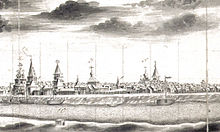

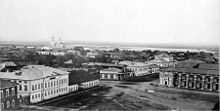


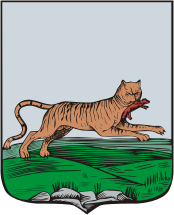



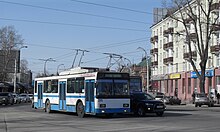

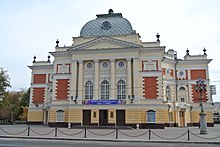
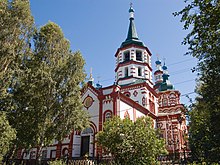
No comments:
Post a Comment